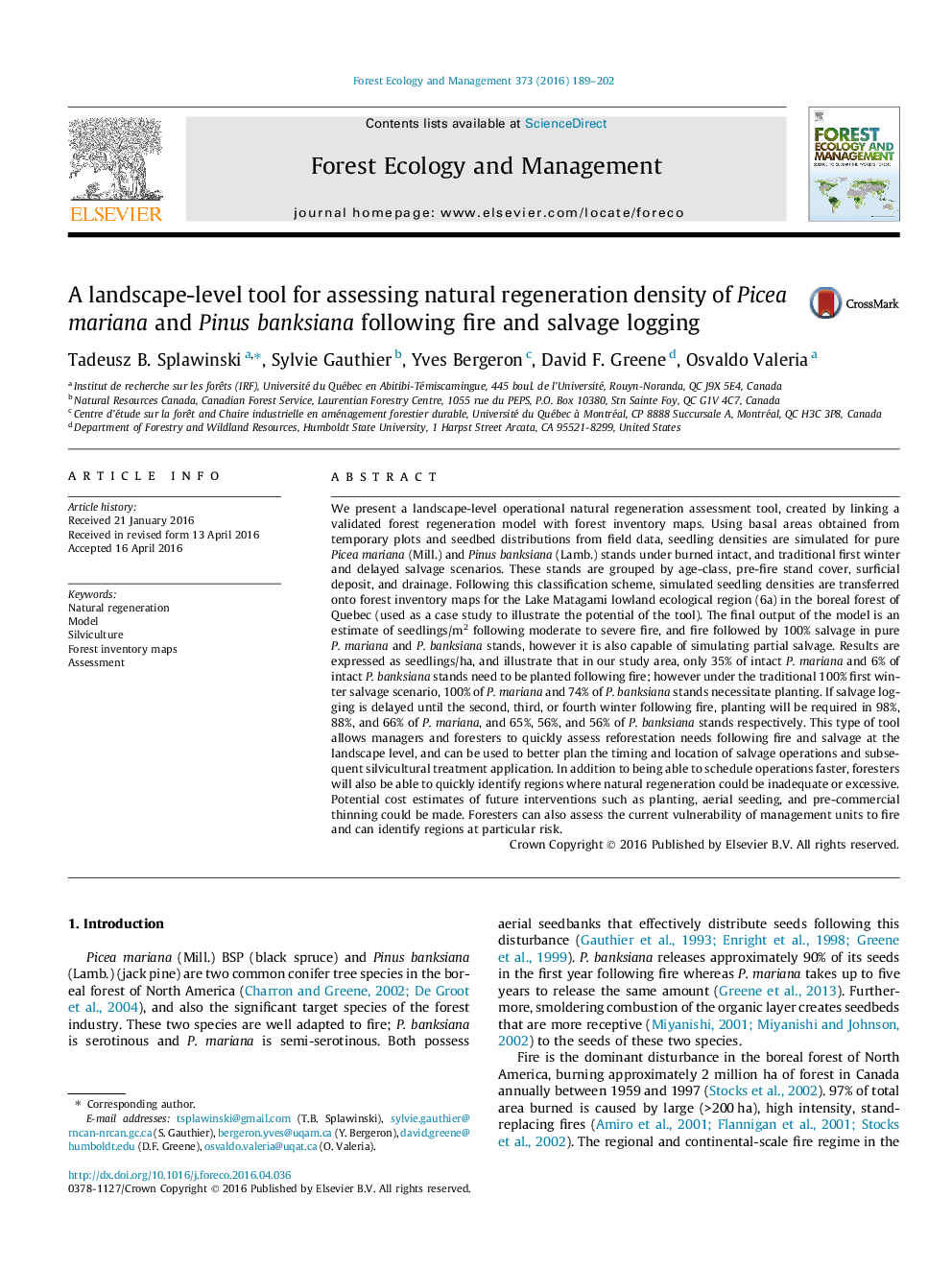| کد مقاله | کد نشریه | سال انتشار | مقاله انگلیسی | نسخه تمام متن |
|---|---|---|---|---|
| 6542263 | 159150 | 2016 | 14 صفحه PDF | دانلود رایگان |
عنوان انگلیسی مقاله ISI
A landscape-level tool for assessing natural regeneration density of Picea mariana and Pinus banksiana following fire and salvage logging
دانلود مقاله + سفارش ترجمه
دانلود مقاله ISI انگلیسی
رایگان برای ایرانیان
کلمات کلیدی
موضوعات مرتبط
علوم زیستی و بیوفناوری
علوم کشاورزی و بیولوژیک
بوم شناسی، تکامل، رفتار و سامانه شناسی
پیش نمایش صفحه اول مقاله

چکیده انگلیسی
We present a landscape-level operational natural regeneration assessment tool, created by linking a validated forest regeneration model with forest inventory maps. Using basal areas obtained from temporary plots and seedbed distributions from field data, seedling densities are simulated for pure Picea mariana (Mill.) and Pinus banksiana (Lamb.) stands under burned intact, and traditional first winter and delayed salvage scenarios. These stands are grouped by age-class, pre-fire stand cover, surficial deposit, and drainage. Following this classification scheme, simulated seedling densities are transferred onto forest inventory maps for the Lake Matagami lowland ecological region (6a) in the boreal forest of Quebec (used as a case study to illustrate the potential of the tool). The final output of the model is an estimate of seedlings/m2 following moderate to severe fire, and fire followed by 100% salvage in pure P. mariana and P. banksiana stands, however it is also capable of simulating partial salvage. Results are expressed as seedlings/ha, and illustrate that in our study area, only 35% of intact P. mariana and 6% of intact P. banksiana stands need to be planted following fire; however under the traditional 100% first winter salvage scenario, 100% of P. mariana and 74% of P. banksiana stands necessitate planting. If salvage logging is delayed until the second, third, or fourth winter following fire, planting will be required in 98%, 88%, and 66% of P. mariana, and 65%, 56%, and 56% of P. banksiana stands respectively. This type of tool allows managers and foresters to quickly assess reforestation needs following fire and salvage at the landscape level, and can be used to better plan the timing and location of salvage operations and subsequent silvicultural treatment application. In addition to being able to schedule operations faster, foresters will also be able to quickly identify regions where natural regeneration could be inadequate or excessive. Potential cost estimates of future interventions such as planting, aerial seeding, and pre-commercial thinning could be made. Foresters can also assess the current vulnerability of management units to fire and can identify regions at particular risk.
ناشر
Database: Elsevier - ScienceDirect (ساینس دایرکت)
Journal: Forest Ecology and Management - Volume 373, 1 August 2016, Pages 189-202
Journal: Forest Ecology and Management - Volume 373, 1 August 2016, Pages 189-202
نویسندگان
Tadeusz B. Splawinski, Sylvie Gauthier, Yves Bergeron, David F. Greene, Osvaldo Valeria,